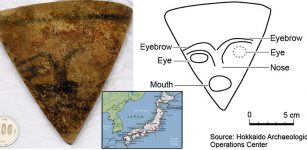First Look At Mysterious 2,700-Year-Old Underground Frescoes Hidden Inside An Urartu Structure
Jan Bartek - AncientPages.com - This archaeological discovery came to light when a group of treasure hunters excavated illegally in the Tusba district of Van, Turkey. These activities led to the discovery of a 2,700-year-old Urartian structure. Once authorities were notified about these events, the area was taken under the protection of the teams affiliated with the Provincial Gendarmerie Command. Soon thereafter, the Van Museum was notified, and scientists investigated this curious ancient place.
Illegal excavators found a mysterious 2,700-year-old Urartu structure. Credit: Yeni Safak
When researchers examined the ancient Urartu structure, they were amazed by the beautifully decorated wall paintings at the entrance of the 16-meter-long tunnel.
The scientific head of the excavation was Atatürk University Faculty of Letters, Archeology Department Lecturer Prof. Dr. Mehmet Isikli said that there are red slipped ceramics from Urartu on the foundations made of very well-preserved mudbrick and basalt. Still, the scientists were more excited by the paintings on the walls. The blue and burgundy frescoes had never been seen before, and a plan to save this ancient art was initiated.
Scientists were amazed by the underground frescoes. Credit: Yeni Safak
Later, Culture and Tourism Provincial Director Erol Uslu, Van Museum Director Fatih Arap, Atatürk University Faculty of Letters Archeology Department Lecturer Prof. Dr. Mehmet Isikli and a team of 6 experts from the Istanbul Restoration and Conservation Central Regional Laboratory, affiliated with the General Directorate of Cultural Heritage and Museums, started an investigation in the region.
The Urartu wall paintings are rare, researchers say. Credit: Yeni Safak
Scientists will attempt to preserve ancient artworks. Credit: Yeni Safak
The teams encountered a large group of buildings 6-7 meters deep in the ground, of different lengths, connected by corridors. It was seen that there were human and animal figures and various decorations on some of the walls of the building, which was determined to belong to the Urartian period.
Excavation and restoration work started, and after two months, scientists say they have made significant progress in their region study.
These ancient paintings tell stories of the past. Credit: Yeni Safak
"When we came and saw it after the illegal excavation, a 16-meter tunnel was opened on the slope of the south hill, and we encountered a find group of Urartian culture that we were aware of during the illegal excavations but that we could not find archaeologically.
These are wall paintings. You know, wall paintings are very delicate and difficult to protect. "Unfortunately, it has not survived to the present day. There are a few examples. We found a few pieces in Erzincan Altintepe. Also, wall paintings were found in this way in a city in Armenia, which is within the borders of the Urartu country. But they were also found after Urartu." These pictures were recovered in pieces, but when we saw the pictures that were unearthed here during the illegal excavation, we were very excited," Professor Dr. Isikli said.
The scientists added this place was the last stronghold of the Urartians, an ancient civilization famous for its magnificent architecture. Just recently, scientists unearthed an ornamental bronze wall plate in the Ayanis Castle built by Urartian King Rusa II. It is also among the most magnificent constructions of the Iron Age Kingdom of Urartu. All these fascinating archaeological discoveries shed new light on the ancient Kingdom of Urartu.
To learn more about the recently unearthed 2,700-year-old structure and its rare frescoes, scientists will continue excavations, but they must proceed cautiously.
The Urartu structure is large and there is much to investigate. Credit: Yeni Safak
"We cut off contact with the air, but we didn't do any digging there. Because we need a very well-protected superstructure to start the excavation there. After that, we will continue the excavation.
If it comes to life, it will be the most important tourism destination in the region."
As Yeni Safak reports, explaining that they carried out excavations to find the architecture on the remaining parts of the hill, Prof. Dr.Isikli said, "Apart from that, what kind of building group do we face in the rest of the hill? What will we find here? What will we encounter? To understand it, we continued excavating to find the architecture in 16 trenches. We have taken that area under protection right now.
See also: More Archaeology News
After developing a comprehensive project there, we continued the excavations. We will be able to do it later. Because if it is put on the agenda as we want, it will be the most important tourism destination in this region. There are many cities like this in the west. Pompeii in Italy, hillside houses in Ephesus. The murals there are very well preserved. It is a very special protected area. It attracts a great number of tourists. We can also see the Pompeii of this place, perhaps in the east, in Van, preserved with such a nature painting. We can bring Ephesus hillside houses to life. Because we don't know what kind of painting or wall paintings are waiting for us inside, what kind of architect is waiting for us," he said.
Written by Jan Bartek - AncientPages.com Staff Writer


























